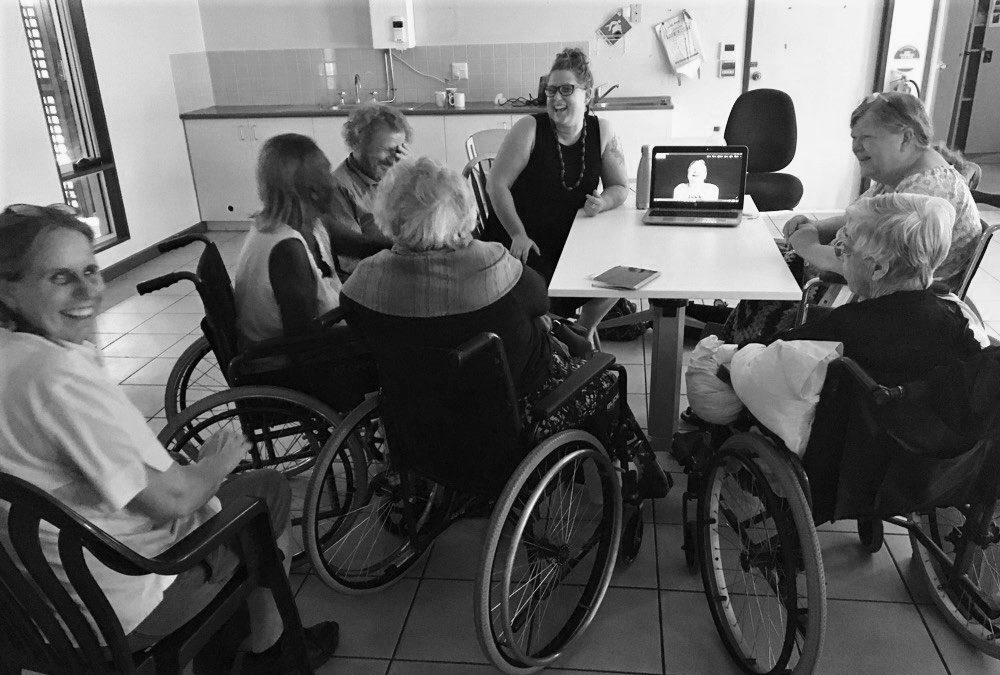Making ‘The Memory Archive’ with Sarah Hope…
— by Eve Pawlik

Artback NT recently teamed up with the City of Palmerston to deliver workshops under the Council’s Voices of Palmerston project. Connecting artists with the community, the project aimed to capture and share the stories of everyday people living, working and playing Palmerston. Here, Artback NT Project Officer Eve Pawlik talks with story-maker and playwright Sarah Hope about her work on the project and the creation of ‘The Memory Archive’.
EP: How did the project The Memory Archive come about? What inspired you?
SH: Well, I saw a documentary about a man who was taking music into aged care facilities in the US and playing it to people with Dementia and Alzheimer’s. He was having these amazing responses from people. I realised how much music can connect you to someone when you don’t have a base connection already.
EP: It seems that there is a big focus on memory and storytelling as a means of connection, do you explore that a lot in your practice?
SH: I think that it is probably the main part of my practice. Especially with community. I am a playwright and I have my own practice in which I explore my own stories. I feel very strongly about the way artists can facilitate spaces for those that don’t usually have the agency to tell their own stories and advocate through storytelling.
EP: Tell me a little bit about the people you spent time with for the project, what surprised you?
SH: I hadn’t worked in this context before so I wasn’t sure what to expect. Everyone was really different and everyone in their own way was actually really funny, like really funny people. You know, great, quirky senses of humour. One lady I really connected with because she’d spent time in Nhulunbuy as I have in my life. That was a lovely point of connection. There was another lady who was just hilarious in the way she just spoke about her life. Then of course speaking to Jacqui and her experiences about living in London during World War 2 was incredible and really kind of reminded me that in Australia, we haven’t experienced that kind of war. And she was a really strong storyteller. The stories about the Territory really opened my eyes to some of the changes that have occurred.
EP: Yeah, and I guess a really interesting aspect to this project, is that all of these people who have come from such different places ended up in the same place, the same aged care facility in Palmerston. Yet, their stories are so diverse as to what led them to be there.
SH: Yeah, absolutely, and what I think happens when we institutionalise people, like in aged care facilities, we do have a tendency to forget that they have long histories. Each individual is seen as almost a collective rather than individuals. Which kind of degrades their story, and their capacity to express.
EP: What was the most memorable response to the project?
SH: Seeing how overwhelmed and touched people were, both as participants and the staff at the aged care facility by looking at the photos and hearing the stories, there were a few tears shared all round. Enjoying each other’s stories too.
EP: And I am remembering Jacqui, looking at her portrait and saying “that’s my grandmother”, not realising it was of her. Do you feel like the project has been important for the families of those people too?
SH: That was too funny. Yes, it is very special for the families too. I’ve lost all my grandparents now and when you are in that situation you realise how valuable it is to treasure people and their stories. I expect some of the families may have heard these stories before, but then again some of the families may not have. Also, there is something about hearing a story in a different way. Sometimes to have someone take the time to tell it back to you in a creative way can make it really powerful.
EP: Has there been any lasting impact on you from this project, how did it hit you?
SH: I keep saying it but this project is really special to me, for a number of reasons, I think getting to know the individuals was very special. In a lot of ways it was this two way exchange, they were really open in allowing me to spend time with them. That was lovely. But also as an artist you can sometimes forget that that the simplest of processes are the most important, the most effective.
EP: Absolutely, the push to be innovative can overcomplicate it sometimes, confuse you from the core of the stories you are representing.
SH: Yeah and the reason why you are doing it because at the end of the day you are trying to support the development of community and agency within individuals. Sometimes the simplest way is the best way to do that – like getting to know people, taking a photo.
See the photographs and hear the stories of The Memory Archive under our Special Projects here!